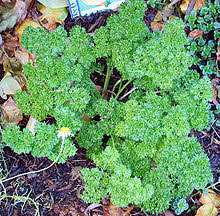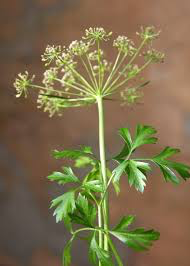Parsley
Scientific Name: Petroselinum crispum
Climate: It grows in any climate - cold, temperate, and hot.
Plant Description: Parsley is a biennial herb. It can grow up to 30 cm in the first year and up to 60 in the second when it is blooming. There are two types of parsley - flat leaf and curly leaf. The flat-leaved type is the most easily cultivated and grown and has a stronger odor than the curly-leaved type. It has small yellow-green flowers.
Cultivation: Seeds are sown in early spring. It is better to sow directly to the ground. You have to soak the seeds in water for a day, sow and cover them with a light layer of compost.
Parsley is planted in full sun or partial shade, but stays moist as it will die if dried. It takes up to four weeks to germinate and in the meantime other plants that grow around it must be removed to prevent competition. Plants should be about 30 centimeters apart. Try not to disturb the roots too much once they are planted.
Parsley has a fairly slow growth. It needs well-drained soil, fertilized with compost. Both varieties grow well during the dry season once established, but must be kept moist.
Harvest the outer leaves as new growth originates from the center of the plant. The leaves can be cut as soon as they are well formed. Ideally, have several plants to be able to cut some leaves from each one. The leaves become bitter and tough as they age, so they are regularly harvested.
 Uses: Parsley serves as food, medicine, spice, and insect repellent. It is high in vitamins A, B, C and K. Vitamin K helps bones to form and can protect against osteoporosis. It also helps blood circulation and the nervous system. Five grams of parsley can give you enough vitamin A for a day, and 25 grams can give you enough vitamin C. It also contains fiber, potassium, magnesium, iron, zinc, calcium, phosphorous, and folic acid. The leaves also have a lot of protein.
Uses: Parsley serves as food, medicine, spice, and insect repellent. It is high in vitamins A, B, C and K. Vitamin K helps bones to form and can protect against osteoporosis. It also helps blood circulation and the nervous system. Five grams of parsley can give you enough vitamin A for a day, and 25 grams can give you enough vitamin C. It also contains fiber, potassium, magnesium, iron, zinc, calcium, phosphorous, and folic acid. The leaves also have a lot of protein.
Fresh leaves and stems can be eaten whole or chopped. It can be used in salads. It is very tasty accompanied by tomatoes, potatoes, fish, eggs and sauces. Parsley can be dried and used as a spice as well. Parsley could help stimulate appetite, improve digestion. It is a diuretic and helps to eliminate liquids, reduce spasms and increase menstrual flow. The leaves contain many antioxidants and other vitamins that can help the immune system to be strong and resistant. High in iron, it is good to help treat anemia. It helps improve digestion and the amount of nutrients you can get from your food. It can also reduce gas and colic. It can be good for controlling high blood pressure with a tea or oil made from the seeds. It is useful to control allergic reactions and insect bites. It is used to control diabetes.
To make tea, mix 15 mg of the dried leaves or root, or five mg of the crushed seeds in a cup of boiling water. Soak for ten minutes and then drain. The usual recommendation is up to three cups a day. The roots can also be medicinal. Do not eat large amounts of the seed or drink seed tea for more than two weeks. Pregnant women, children, or people with kidney problems should not consume the seed. Avoid parsley if you are allergic to celery or carrots.
Pests and Diseases: It is affected by aphids, slugs and snails. The last two can be controlled with eggshell and beer respectively.
En español: Perejil

